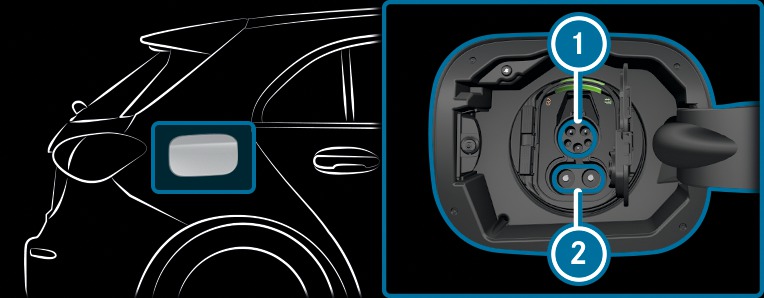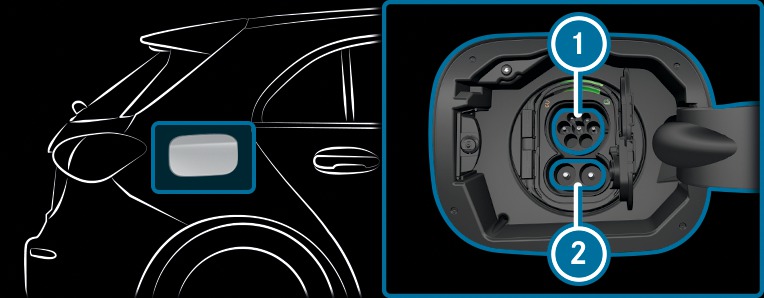Lengthy idle periods with a high charge level may result in an accelerated ageing of the high-voltage battery.
Exhaustive discharging caused by the battery being idle for lengthy periods can damage the high-voltage battery.
Recharge the high-voltage battery if the charge level is insufficient.
As a result of its basic characteristics, the amount of energy available from the high-voltage battery decreases over the course of its life.
Due to this, the maximum range that can be achieved by the vehicle is reduced and the maximum output (acceleration) of the vehicle can be reduced.
An anticipatory driving style More
Reduced use of electrical consumers
Having the vehicle regularly maintained
The charging time of the high-voltage battery may change over the course of its life.
You can check the charge level of the high-voltage battery in the multimedia system More
Depending on the national version, your vehicle is equipped with one of the following vehicle sockets.
You can charge the high-voltage battery with both alternating current (mode 2 or 3) and direct current (mode 4).


 Socket for charging with alternating current
Socket for charging with alternating current  Socket extension for charging with direct current
Socket extension for charging with direct current
When using a CCS (Combined Charging System) charging cable to charge with direct current, both areas of the vehicle socket are covered by the charging cable connector.
Charging through recuperation while the vehicle is in motion
Stationary charging with alternating current via:
Mains socket (mode 2)
Wallbox (mode 3)
Charging station (mode 3)
Stationary charging with direct current via:
Charging station (mode 4)
The high-voltage battery can be charged in a nominal voltage range from 100 V to 400 V.
Charging facility – mains socket, wallbox or charging point
Charging mode and charging capacity
Battery charge status
Outside temperature
Recharge efficiency describes the ratio of the amount of energy dispensed by the charging facility to the amount of energy absorbed by the high-voltage battery. When charging, different levels of charging losses always occur, for example due to heat development when charging or auxiliary consumers that are switched on. For this reason, recharge efficiency in charging the high-voltage battery is always less than 100%.
This means that the amount of energy dispensed shown by the charging facility for the charging process is always higher than the amount of energy actually absorbed by the high-voltage battery. Thus, it cannot equal the increase in the charge level displayed in the vehicle.
It is recommended that you charge the high-voltage battery at a wallbox or charging station due to the improved charging performance and better charging efficiency offered.
High or low outside temperatures
Electrical auxiliary consumers in the vehicle being switched on, e.g. operating the climate control system
Extended periods without charging
High or low outside temperatures
Extended periods without charging
The maximum available charge current of the charging facility
The charging current set (mode 2) in the multimedia system More

